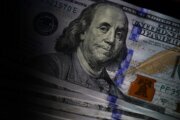When it comes to economic forecasts, the U.S. Treasury yield curve is a go-to gauge for many seasoned investors. And for good reason: An inverted yield curve has accurately foreshadowed all 10 recessions since 1955, according to data from the Federal Reserve Bank of San Francisco.
But what exactly is an inverted yield curve? Simply put, it’s when the interest yield on three-month or two-year Treasury securities is greater than for 10-year Treasury securities. This development often signals to investors that economic conditions will soon turn sour, and that the central bank will respond with monetary rate cuts.
[Sign up for stock news with our Invested newsletter.]
For example, in January of this year, the rate for the three-month Treasury bill was 4.71%, while the rate for the 10-year Treasury bond was 3.44%. That’s a spread of -127 basis points between the respective securities, according to data from the Federal Reserve Bank of Cleveland.
In early February, the 10-year Treasury yield dropped more than 0.85 percentage point below the two-year yield, in the widest such inversion since 1981.
Here are some factors to consider when looking at inverted yield curves as recession indicators:
— What an inverted yield curve means to investors.
— How long before recession does an inverted yield curve appear?
— Inverted yield curve as one piece of the puzzle.
— Inverted yield curve as an imprecise signal of recession.
— What to do when a yield-curve inversion happens.
[Read: How Fed Interest Rate Increases Affect Student Loans.]
What an Inverted Yield Curve Means to Investors
While it may seem counterintuitive, an inverted yield curve signals that long-term investors have settled for lower returns relative to what is available from short-term securities, even though the presumed risk is higher for longer-term securities.
Why? For starters, risk can be interpreted differently among investors. Some long-term investors may view an inverted yield curve as their last opportunity to lock in current interest rates before they turn south. Lower interest rates often reflect a slow-growth economic environment, and possibly, an imminent recession.
How Long Before Recession Does an Inverted Yield Curve Appear?
Given the mercurial lag time between when an inverted yield curve emerges and when a recession begins, the word “imminent” may not mean much to investors. The average lag time can span 12 to 24 months, according to the San Francisco Fed. According to data from Statista, there was a long, 22-month lag time after the yield curve inverted in January 2006; however, there was only a six-month lag time in August 2019.
In January 2023, the Cleveland Fed plotted a 63.3% chance of a recession within the next 12 months. That’s up from nearly a 54% chance this past December and roughly a 42% chance in November.
“We closely monitor the 10-year/three-month spread, which finally inverted in October 2022. Since then, inversions have steepened as recession probabilities advanced,” says Jon Maier, chief investment officer for Global X ETFs.
“A sudden steepening of the curve typically follows inversions just before a recession is confirmed,” Maier says. “From a market perspective, the lead time between yield-curve inversions and risk-asset recoveries can vary widely — although we are already seeing signs of global growth divergence as peak pessimism fades.”
[Read: How to Invest in Cryptocurrency.]
Inverted Yield Curve as One Piece of the Puzzle
Scott Knapp, chief market strategist for CUNA Mutual Group, has a more nuanced take on the economic implications of the inverted yield curve. “The best approach to anticipating changes in direction for the economy is to evaluate several data points that, when viewed together, create a picture of what could happen next,” he says. “Academics and economists have long subscribed to this mosaic approach to forecasting.”
For example, an economic outlook can be informed by combining high-frequency data, such as weekly jobless claims and daily credit-card usage, with longer-term data, such as real GDP and headline unemployment, says Knapp. “The shape of the yield curve can be added as a contributor, but the weight of its contribution to the process should probably be reduced,” he says.
O. Emre Ergungor, a contributing author and former employee of the Cleveland Fed, acknowledged the “concerns over the stability of the predictive power of the term and credit spreads” in his article entitled “Recession Probabilities.” In the article, Ergungor suggests that corporate profits are “financial measures that lack the forward-looking nature of the financial market data but should still have predictive power for future economic activity.” He adds, “Intuitively, a change in corporate profits should be highly correlated with industrial production and investment. One would expect firms to produce and invest more if their profits are rising.”
[READ How to Determine Your Investment Risk Tolerance]
Inverted Yield Curve as an Imprecise Signal of Recession
Although an inverted yield curve is a frequently referenced warning signal for economic forecasts, especially recessions, it does not provide insight regarding the severity or duration of looming recessions, nor does it clarify how investors can process the warning signal for their own planning needs.
In fact, since 1965, the S&P 500, a broad representation of the U.S. stock market, has experienced a median return of 8.5% in the 12 months that followed eight two-year/10-year yield-curve inversions, according to data from LPL Research and the St. Louis Federal Reserve Bank.
Better still, despite any economic headwinds that may arise in the coming months, Northern Trust’s five-year outlook is fairly sanguine for a variety of asset classes:
— U.S. stocks: 6.6%
— Developed non-U.S. stocks: 6.2%
— Listed real estate: 6.8%
— U.S. investment-grade bonds: 3.7%
— Cash: 2.8%
What to Do When a Yield-Curve Inversion Happens
Is it wise, then, for investors to simply ignore any warning signals that an inverted yield curve may imply?
Economists, for the most part, would say no. Yield-curve inversions are instructive and can raise investors’ awareness about potential economic hazards around the bend.
Though it might help to know a wild ride is in store, long-term investors using a buy-and-hold strategy will mostly focus on choosing quality investments, diversifying and riding out market fluctuations rather than trying to get off the roller coaster at the right time.
In addition, since the National Bureau of Economic Research estimates that the average recession only lasts for about 17 months, investors can reasonably question whether an inverted yield curve may have any real impact on their long-range planning priorities, like saving well for retirement.
More from U.S. News
ESG Investing 101: What Is an ESG Score?
How to Invest in Stocks for Beginners
Inverted Yield Curve: Is It Still a Recession Indicator? originally appeared on usnews.com







